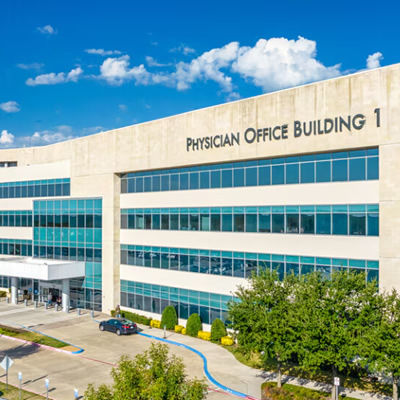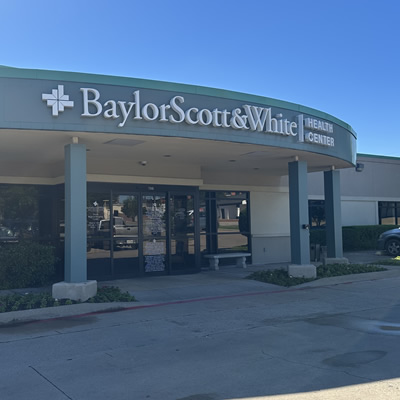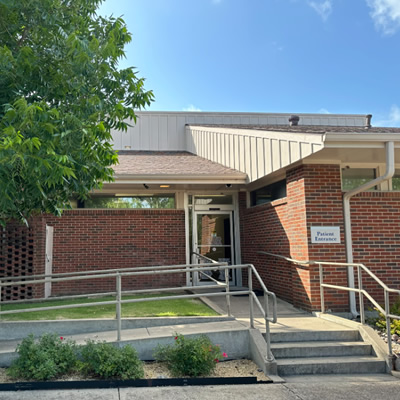Baylor Scott & White Texas Urogynecology Associates is staffed with experienced physicians specially trained in the areas of urogynecology and pelvic reconstructive surgery who work with patients to alleviate if not eliminate symptoms and improve the quality of life. The physicians here use a wide range of advanced surgical and nonsurgical treatment options available to manage the various types of pelvic floor disorders in a compassionate environment.
Millions of women experience the inconvenience, discomfort and embarrassment of urinary incontinence and other types of voiding dysfunction. These symptoms are most likely caused by a weakening of the pelvic floor. While many patients may find these symptoms disconcerting, there is hope.
Baylor Scott & White Texas Urogynecology Associates' main offices are in Dallas, Plano and Irving.

Baylor Scott & White Texas Urogynecology Associates - Dallas -test
4501 Swiss Ave , Dallas, TX, 75204
- Monday: 8:30 am - 5:00 pm
- Tuesday: 8:30 am - 5:00 pm
- Wednesday: 8:30 am - 5:00 pm
- Thursday: 8:30 am - 5:00 pm
- Friday: 8:30 am - 5:00 pm

Baylor Scott & White Texas Urogynecology Associates - Grapevine -test
1631 Lancaster Dr Ste 370, Grapevine, TX, 76051

Baylor Scott & White Texas Urogynecology Associates - Irving -test
2001 N MacArthur Blvd Ste 425, Irving, TX, 75061
- Monday: 8:30 am - 5:00 pm
- Tuesday: 8:30 am - 5:00 pm
- Wednesday: 8:30 am - 5:00 pm
- Thursday: 8:30 am - 5:00 pm
- Friday: 8:30 am - 5:00 pm

Baylor Scott & White Texas Urogynecology Associates - McKinney -test
5236 W University Dr Ste 2700, McKinney, TX, 75071

Baylor Scott & White Texas Urogynecology Associates - Plano -test
4601 Old Shepard Pl Bldg 3, Ste 305, Plano, TX, 75093
- Monday: 8:30 am - 5:00 pm
- Tuesday: 8:30 am - 5:00 pm
- Wednesday: 8:30 am - 5:00 pm
- Thursday: 8:30 am - 5:00 pm
- Friday: 8:30 am - 5:00 pm

Baylor Scott & White Texas Urogynecology Associates - Terrell -test
200 N Virginia St , Terrell, TX, 75160

Baylor Scott & White Texas Urogynecology Associates - Waxahachie -test
1505 W Jefferson St Ste 160, Waxahachie, TX, 75165
Insurances accepted
Baylor Scott & White has established agreements with several types of insurance to ensure your health needs are covered.
-
Aetna - (25)Aetna Medicare Dual Complete Plan (HMO D-SNP)HMOHealth Network OptionOpen Access SelectOpen Access Managed ChoiceAetna Medicare Eagle Plan (PPO)Managed ChoiceAetna Medicare Freedom Plan (PPO)Aetna Medicare Choice II Plan (PPO)Open Access Elect ChoiceCHIPAetna Medicare Freedom Preferred Plan (PPO)QPOSAetna Medicare Eagle II (PPO)Aetna Medicare Value Plan (HMO)Choice POS IIAetna Signature AdministratorsTexas Preferred Plus IISTARHealth Network OnlyAetna Medicare Choice Plan (PPO)SelectOpen Choice PPOAetna Medicare Prime Plan (HMO)Group Retiree Medicare PPO - Limited to Exxon/Mobil
-
American Health Advantage of Texas - (1)American Health Advantage of Texas HMO I-SNP
-
Baylor Scott & White Health Plan - (14)BSW Premier HMO-GroupBSW Access PPOBSW Plus HMO-GroupBSW Plus HMO-Individual/FamilyBSW Plus PPO-GroupBSW Plus PPO-Individual/FamilyBSW Premier HMO-Individual/FamilyBSW SeniorCare Advantage HMOBSW SeniorCare Advantage PPOBSWH Employee Network (SEQA & EQA)BSWH Employee Network Premium (PPO)/ HDHPCovenant Health AdvantageBSW Preferred HMO - Individual MarketplaceBSW Extended PPO
-
Blue Cross Blue Shield - (53)Blue Advantage Plus - SilverBlue Cross Group Medicare Advantage (PPO)Federal Basic OptionConsumer Directed HealthSelectBlue EssentialsBlue Advantage Plus - GoldBlue PremierTRS-ActiveCare Primary HDTRS-Care StandardBlue Advantage - BronzeBlue Advantage - GoldBlue Advantage Plus - BronzeFederal Standard OptionParPlanBlue Essentials AccessBlue ChoiceFederal FEP Blue FocusBlue Advantage - SilverTRS-ActiveCare PrimaryBlue Cross Medicare Advantage Dual Care Plus (HMO SNP)TRS-ActiveCare 2Blue Cross Medicare Advantage (HMO)Blue Premier AccessSTAR KidsBlue Essentials - TRS-ActiveCare Primary+Blue Cross Medicare Advantage Choice Plus (PPO)CHIPBlue Choice - HealthSelect of Texas - Out-of-StateBlue Cross Medicare Advantage Saver (HMO)Blue Choice - TRS-ActiveCare HDBlue Cross Medicare Advantage Health Choice (PPO)Blue Choice - TRS-Care StandardBlue Cross Medicare Advantage Choice Premier (PPO)Blue Choice - City of DallasBlue Cross Medicare Advantage Saver Plus (PPO)Blue Cross Medicare Advantage Flex Access (PPO)Blue Choice - Consumer Directed HealthSelect - Out-of-StateBlue Choice - Texas A&MBlue Cross Medicare Advantage Flex (PPO)Blue Essentials - HealthSelect of TexasSTARBlue Cross Medicare Advantage Value (HMO)Blue Cross Medicare Advantage Dental Value (HMO)High Performance NetworkBlue Essentials - TRS-ActiveCare PrimaryBlue Choice - TRS-ActiveCare 2Blue Cross Group Medicare Advantage Open Access (PPO)Blue Cross Medicare Advantage Classic (PPO)Blue Cross Medicare Advantage Dental Premier (PPO)Blue Cross Medicare Advantage Protect (PPO)Blue Essentials - Consumer Directed HealthSelectHealthSelectTRS-ActiveCare Primary+
-
Centivo Network - (1)Centivo Network - Baylor Scott & White Premier
-
Cigna - (18)Cigna Medicare AdvantageCigna HealthSpringPoint of Service Open AccessOpen Access Plus In-NetworkOpen Access PlusChoice FundOpen AccessCigna Preferred Medicare (HMO)LocalPlus In-NetworkCigna Preferred Savings Medicare (HMO)BSW Extended PPOCigna TotalCare (HMO D-SNP)LocalPlusCigna Preferred Savings Medicare (PPO)Cigna True Choice Medicare (PPO)Cigna True Choice Courage Medicare (PPO)NFL Dedicated Hospital Network ProgramCigna+Oscar
-
Curative - (1)Curative
-
DFW ConnectedCare - (1)American Airlines Employee Benefit Plan
-
EHN - (1)Employers Health Network
-
HealthSmart - (2)Preferred NetworkAccel Network
-
Humana - (11)National POSPPOHumana Gold Choice (PFFS)Humana Gold Plus (HMO)Humana Honor (PPO)HumanaChoice (PPO)Humana USAA Honor with Rx (PPO)Humana Gold Plus SNP-DE (HMO D-SNP)ChoiceCareHumana PreferredHumanaChoice (Regional PPO)
-
Imagine Health - (1)Imagine Health Network
-
Nebraska Furniture Mart - (3)PearlOnyxEmerald
-
Parkland Community Health Plan - (2)CHIPSTAR - HealthFirst
-
PHCS Network - (1)PHCS Primary PPO
-
ProCare - (1)Advantage Institutional Special Needs Plan (HMO POS I-SNP)
-
QuickTrip - (1)Employee Benefit Plan
-
Superior Health Plan - (20)Ambetter Core EPO - SilverAmbetter Core EPO - BronzeWellcareSTAR+PLUSAmbetter Core EPO - GoldWellcare by Allwell Dual Access Harmony (HMO D-SNP)Wellcare by Allwell Patriot No Premium (HMO)Wellcare TexanPlus No Premium (HMO)Wellcare Assist (HMO)Wellcare Dual Access (HMO D-SNP)Wellcare No Premium Open (PPO)Wellcare Dual Liberty (HMO D-SNP)Superior STAR+PLUS (MMP)Wellcare Giveback (HMO)Wellcare Specialty No Premium (HMO C-SNP)Wellcare by Allwell Dual Liberty Nurture (HMO D-SNP)Wellcare Dual Access Open (PPO D-SNP)Wellcare No Premium Rx Plus Open (PPO)Wellcare by Allwell Complement Assist (HMO)Wellcare by Allwell
-
TriWest HealthCare - (1)Community Care Network
-
United HealthCare - (33)All SaversUnitedHealthcare Medicare Advantage Choice (Regional PPO)OptionsNexus ACO - Referral RequiredNexus ACO - Open AccessNavigate PlusCharterAARP Medicare Advantage SecureHorizons Plan 2 (HMO-POS)AARP Medicare Advantage Walgreens (PPO)AARP Medicare Advantage SecureHorizons Plan 1 (HMO-POS)SurestErickson Advantage Liberty without Drugs (HMO-POS)SelectErickson Advantage Liberty with Drugs (HMO-POS)Choice PlusErickson Advantage Signature with Drugs (HMO-POSCoreCharter BalancedEDGENavigateErickson Advantage Freedom (HMO-POS)UnitedHealthcare Group Medicare Advantage (PPO)Select PlusCore EssentialUnitedHealthcare Assisted Living Plan (PPO I-SNP)Erickson Advantage Guardian (HMO-POS I-SNP)ChoiceErickson Advantage Champion (HMO-POS C-SNP)Charter PlusUnitedHealthcare Nursing Home Plan (PPO I-SNP)Navigate BalancedAARP Medicare Advantage Patriot (HMO-POS)AARP Medicare Advantage Choice (PPO)
-
University Mary Hardin-Baylor - (1)University of Mary Hardin-Baylor
-
WellMed - (15)AARP Medicare Advantage Choice (PPO)AARP Medicare Advantage SecureHorizons Plan 2 (HMO-POS)UnitedHealthcare Medicare Advantage Ally (HMO POS CSNP)UnitedHealthcare Dual Complete (HMO DSNP)UnitedHealthcare Dual Complete Select (HMO POS DSNP)AARP Medicare Advantage (HMO-POS)AARP Medicare Advantage (HMO)AARP Medicare Advantage Patriot (HMO-POS)AARP Medicare Advantage Walgreens (PPO)UnitedHealthcare Group Medicare Advantage (HMO)AARP Medicare Advantage SecureHorizons Plan 1 (HMO-POS)UnitedHealthcare Medicare Silver (Regional PPO CSNP)UnitedHealthcare Medicare Advantage Choice (Regional PPO)UnitedHealthcare Medicare Gold (Regional PPO CSNP)UnitedHealthcare Dual Complete Choice (Regional PPO DSNP)
-
FirstCare Health Plans - (2)CHIPFirstCare Select Plus HMO Network
We couldn’t find any results for ""
Urogynecology conditions
Bowel incontinence
Bowel incontinence is the loss of bowel control, leading to an involuntary passage of stool. This can range from occasionally leaking a small amount of stool and passing gas to completely losing control of bowel movements.
Constipation
Constipation is most often defined as having a bowel movement less than three times per week. It usually is associated with hard stools or difficulty passing stools. You may have pain while passing stools.
Cystocele
A prolapse or bulging of the bladder into the vagina is called a cystocele.
Enterocele
Prolapse or bulging of the small intestine into the space between the rectum and vagina is known as an enterocele.
Interstitial cystitis
Interstitial cystitis is a long-term (chronic) inflammation of the bladder wall.
Overactive bladder
Urge incontinence (commonly known as an overactive bladder) is the strong, sudden need to urinate due to bladder spasms or contractions.
Rectovaginal fistula
Abnormal connections from a tract between the rectum and vagina is called a rectovaginal fistula. It causes the passage of gas or fecal material in an uncontrolled manner from the vagina.
Urinary incontinence
Urinary incontinence (also known as bladder incontinence) happens when you are not able to keep urine from leaking from your urethra, the tube that carries urine out of your body from your bladder.
Uterine prolapse
Uterine prolapse describes falling or sliding of the uterus from its normal position in the pelvic cavity into the vaginal canal.
Vaginal vault prolapse
This is a condition that occurs in women who have previously undergone hysterectomy in which the ligaments that normally hold the upper vagina in place have torn or weakened and allow the upper vagina to fold down into itself, or to protrude through the vaginal opening.
Vesicovaginal fistula
Abnormal connections between the bladder and the vagina, resulting in uncontrolled loss of urine from the vagina is called a vesicovaginal fistula.
Vestibulitis
If vulvodynia localized to the vulvar region, it tends to be associated with a highly localized “burning” or “cutting” type of pain referred to as vestibulitis.
Sexual wellness conditions
Sexual dysfunction overview
After many years of experience delivering quality care to women, our providers have discovered that sexual dysfunction is highly prevalent among our female patients. We realize that this is often an uncomfortable topic for many women. With this in mind, we make it our goal to assist women in achieving renewed sexual health and happiness by offering treatment and consultation in a comfortable and confidential environment.
Sexual difficulties may begin early in a person's life, or they may develop after an individual has previously experienced enjoyable and satisfying sex. A problem may develop gradually over time or may occur suddenly as a total or partial inability to participate in one or more stages of the sexual act. The causes of sexual difficulties can be physical, psychological or both.
Diminished arousal function
This is described as poor lubrication, possibly resulting from insufficient excitement and stimulation, hormonal changes or medications.
Diminished sexual desire
Decreased libido may be caused by a decrease in the normal production of estrogen or testosterone. Diminished sexual desire may also be a result of aging, fatigue, pregnancy or medications.
Orgasm dysfunction
A persistent delay or absence of orgasm following a normal excitement phase.
In-office urogynecology procedures
Bladder instillations
Bladder instillation is a therapy offered to manage symptoms of Interstitial Cystitis (IC). Some find it helpful to get medicine inserted directly into their bladders. A series of these instillations is usually done in the office. Treatments can be one to two times a week for six to eight weeks.
Botulinum toxin (Botox)
Botox relaxes the bladder muscle. This allows more urine to be held in the bladder before you have to go to the bathroom. Botox injections are usually performed at the clinic. You do not need general anesthesia or a hospital stay. You can usually drive yourself and can return to work immediately after the procedure. Most people do not find these injections painful. Your provider uses a small camera and needle to inject Botox into the bladder wall. Ask your provider if Botox is right for you.
Cystoscopy
Cystoscopy is a procedure that lets your doctor look inside of your urethra and bladder using a special camera, called a cystoscope. Cystoscopy is a short procedure that can be done in the office with little pain. You will often be able to watch the images on the screen while it is being done. It takes about 10 to 20 minutes to set up and five minutes to complete the procedure.
MonaLisa Touch
MonaLisa Touch utilizes fractional CO2 laser for the treatment of certain gynecologic conditions such as vaginal atrophy (thinning of the vagina that occurs in the absence of estrogen and causes symptoms of vaginal burning, irritation, and dryness) and lichen sclerosis. The laser treatment helps restore gynecologic health by generating new collagen, elastin and vascularization. Generally three treatments are provided, six weeks apart.
Pelvic floor therapy (PFT)
PFT is a technique that allows us to assess your pelvic floor muscle function. The muscles may be weak or tight. The goal is to have the best muscle function possible. Most women find that pelvic floor muscle exercises (Kegels) help improve symptoms. For the best effect, work with a trained provider to learn the techniques. It may take three to six months of regular pelvic floor muscle exercise to see results.
Peripheral nerve evaluation (PNE)
The basic evaluation (also referred to as peripheral nerve evaluation or PNE) is typically used to evaluate patients with bladder control problems. It is initiated through a simple, in-office procedure, during which the lead is placed in the upper buttock.
Tibial nerve stimulation therapy
There are many nerves involved in bladder function. Nerve stimulators help control these nerves, reducing the need to urinate often. Tibial nerve stimulation is similar to acupuncture. A small needle is inserted near a nerve in the ankle and connected to an external device that delivers small pulses to the nerve. Each treatment lasts approximately 30 minutes, and you would typically receive 12 treatments one week apart. After the first 12 weeks, your provider will evaluate your response to treatment and determine if additional treatments are necessary.
Urethral bulking agents
In this procedure, a substance is injected near the urethra to ’’bulk up" the walls. This works well when a sphincter muscle that circles the urethra weakens. There are different types of bulking agents. This outpatient procedure is usually done in the office. It is low risk and allows you to continue to be active immediately, but wears off after several months. The injections will need to be repeated.
Urodynamics study
Urodynamics is a series of tests that evaluate how well your bladder, urinary sphincter and urethra work. These tests focus on how well the bladder fills and empties. Urodynamics tests examine what the bladder and urethra are doing if urine leakage occurs. For example, the tests can show if involuntary bladder contractions (spasms) are causing urinary incontinence. The results of this study assist your Urogynecologist in determining which treatment options will be most effective for you.
Vaginal pessary
A pessary is a silicone device inserted into the vagina. It is similar to a diaphragm. Pessaries push the urethra closed to help control urine leakage. They still allow you to urinate normally when you need to. Some women wear a pessary only when they exercise. Others leave it in all the time.
Pay bill
Baylor Scott & White Health is pleased to offer you multiple options to pay your bill. View our guide to understand your Baylor Scott & White billing statement.
We offer two online payment options:
- Make a one-time payment without registering by selecting the "Pay a Bill as a Guest" option.
- Enroll or login to your MyBSWHealth account to view account balances and statements, setup a payment plan or enroll in paperless statements.
Other payment options:
-
Pay by mail
To ensure that your payment is correctly applied to your account, detach the slip from your Baylor Scott & White billing statement and return the slip with your payment. If paying by check or money order, include your account number on the check or money order.
Please mail the payment to the address listed on your statement.
-
Pay by phone
Payments to HTPN can be made over the phone with our automated phone payment system 24 hours a day, seven days a week. All payments made via the automated phone payment system will post the next business day. Please call 1.866.377.1650.
If you need to speak to someone about a bill from a Baylor Scott & White Hospital, our Customer Service department is available to take payments over the phone from Monday through Friday from 8:00 AM - 5:00 PM and can be reached at 1.800.994.0371.
-
Pay in person
Payments can be made in person at the facility where you received services.
Financial assistance
At Baylor Scott & White Health, we want to be a resource for you and your family. Our team of customer service representatives and financial counselors are here to help you find financial solutions that can help cover your cost of care. We encourage you to speak to a team member before, during or after care is received.
Patient forms
To ensure that your visit to our office is as convenient and efficient as possible, we are pleased to offer our registration forms online. The patient registration form may be completed electronically and printed for better legibility or completed manually.

